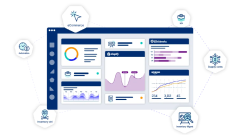
WooCommerce is the world’s most popular ecommerce platform, currently powering over 20% of all online stores. Its flexibility, user-friendly interface, and strong community support make it the go-to choice for many small business owners launching their online brands.
Another great feature that makes WooCommerce so appealing is that it comes with its own built-in inventory management system. This means right out of the box, you have tools to help you track your products and manage stock levels.
In this article, we’ll take a closer look at WooCommerce’s native inventory capabilities and examine some of its shortcomings, which include lack of support for multi-channel stock tracking, absence of comprehensive supplier management and warehouse coordination features, and minimal reporting capabilities.
More importantly, we’ll show you how connecting WooCommerce with a dedicated inventory management system like Cin7 can help you overcome some of these shortcomings, and unlock advanced functionalities that help you achieve greater visibility and control over your inventory.
Does WooCommerce Do Inventory Management?
Yes. WooCommerce offers a set of native inventory management features to help online store owners track products and manage their stock. These include:
- Stock quantity tracking: Woocomer allows you to set and update stock quantities for each product and product variation. The tool then automatically adjusts these quantities as customers place orders on your online store.
- Low-stock and out-of-stock notifications: You can set up automatic alerts for when stock levels fall below a certain predefined threshold.
- Backorder options: With WooCommerce, you have control over how to handle out-of-stock items. You can choose to hide them from your storefront or allow customers to place backorders.
- Hold stock for unpaid orders: WooCommerce can temporarily reserve stock for customers who begin checkout but don’t complete payment.
Where WooCommerce Inventory Management Falls Short
WooCommerce’s built-in inventory management features work well for small stores with a limited product catalog and a single sales channel.
But as your business grows, such as if you expand your product line significantly or start operating across multiple channels and locations, its native capabilities can quickly become restrictive. There are several specific areas where this native system falls short.
First, WooCommerce doesn’t offer real-time multi-channel inventory management if you sell in other places like Amazon, eBay, or physical retail stores. This can cause stock discrepancies, overselling, and fulfillment delays if you're not using a third-party tool to keep everything in sync.
Similarly, WooCommerce doesn’t natively track inventory across different physical locations, such as different warehouses, distribution centers, or retail stores.
Another limitation is its manual inventory processes is that, while WooCommerce adjusts stock levels when an order is placed, other key tasks like reordering stock, updating purchase orders, or managing supplier data must be done manually or with custom-built solutions. As operations grow, these manual processes become time-consuming and prone to error.
WooCommerce’s reporting and analytics capabilities are also quite basic. While it provides essential data such as low stock alerts and stock status, it lacks advanced tools to help you glean useful insights like trends or patterns from raw data that can inform smarter decision-making.
Extending WooCommerce Capabilities with Dedicated Inventory Management Software
If the native inventory management features of WooCommerce are no longer meeting your needs, the best move is to integrate the platform with a dedicated advanced inventory management software solution.
Cin7 is one such solution. This cloud-based platform offers powerful tools that extend WooCommerce’s native functionality and streamline and enhance every aspect of your inventory management.
Key Features of Cin7’s WooCommerce Integration
Integrating Cin7 with your WooCommerce store unlocks several powerful inventory management software features, including the following.
Real-time Inventory Syncing Across Sales Channels
When you link your WooCommerce store with Cin7, your inventory levels get updated instantly across all the places you sell your products, including your WooCommerce store, physical retail stores, and marketplaces like Amazon or eBay.
So, if someone buys a product in any one of those places, Cin7 immediately reduces the available stock number everywhere else too. This way:
- You don’t have to manually update stock numbers on each sales channel.
- You avoid selling more items than you actually have (i.e., overselling).
- Your stock information stays accurate and consistent no matter where customers shop.
Centralized Control of Inventory, Purchasing, and Fulfillment
Cin7 gives you one central system where you can manage everything related to your products. This includes:
- Track how much stock you have (inventory).
- Handling orders you place with suppliers (purchasing).
- Managing the process of getting orders ready and shipped to customers (fulfillment).
This centralized setup improves coordination and keeps every part of your business working together seamlessly.
Built-in Warehouse and Order Automation
Cin7 significantly boosts operational efficiency through its built-in warehouse and order automation features.
This includes features like optimized instructions for picking and packing items (which enables warehouse staff to work more efficiently and with fewer mistakes), automated routing of orders to the correct fulfillment location, and direct integration with shipping carriers and 3PLs (third-party logistics providers).
This automation cuts down manual work, minimizes errors, and speeds up order processing and shipping.
Multi-Location and Multi-Warehouse Stock Tracking
Cin7 allows you to precisely track stock levels in multiple warehouses, retail stores, or distribution centers. You can see at a glance exactly how much product is available in each location. This is important for several reasons.
For example, if one warehouse is running low on a popular item but another location has surplus stock, you can quickly initiate an internal transfer to balance inventory and avoid stockouts.
Additionally, having real-time stock data across all locations helps you fulfill orders faster by shipping from the closest warehouse to the customer, reducing delivery times and shipping costs.
If you need help with production management, Cin7 also has you covered. Through Cin7, you can track the progress of work orders in real time, assign tasks to work centers, and monitor production steps as they happen. This allows you to coordinate resources effectively, catch issues early, reduce errors, and keep your production processes running smoothly and on time.
Integration With 700+ Tools
Cin7 seamlessly connects with a vast ecosystem of business critical tools with over 700 software integrations. This includes popular accounting software (like QuickBooks and Xero), ecommerce platforms like BigCommerce and WooCommerce, major shipping carriers, and EDI and 3PL (third-party logistics provider) connections.
Essentially, Cin7 allows you to connect every part of your business, from the moment you purchase from suppliers to fulfilling your customer orders (and even returns) in one automated system.
Centralized Product Catalog with BOM and Kits
Cin7 supports complex inventory setups, such as bundles (kits) and bill of materials (BOMs). You can define products that are made up of multiple components.
When a customer buys a bundled product or a product made from multiple components through your WooCommerce store, Cin7 automatically reduces the stock count not only of the finished product but also of each individual component that makes it up. This way, your inventory levels stay accurate for both assembled items and their parts.
This feature is especially useful for businesses that assemble products from multiple parts or sell sets of products together.
Built-In Analytics and Forecasting
Cin7 inventory forecasting software turns raw stock data from WooCommerce into clear, actionable insight through its advanced analytics and reporting features.
For example, it can analyze sales trends to predict which products are likely to be in high demand during upcoming seasons, helping you stock up proactively. It can also highlight slow-moving inventory so you can take appropriate action, such as running promotions or sales.
How to Connect Cin7 with Your WooCommerce Store
Connecting Cin7 to your WooCommerce store is very straightforward. Here are the steps to follow. Connect to Cin7 Omni or Connect to Cin7 Core.
Step 1: Install the WooCommerce Integration in Cin7
Start by logging into your Cin7 account with administrator access. From the main navigation, head to the App Store and look under the Ecommerce section. Find WooCommerce and request the app installation. After approval, the integration will appear in your integrations list.
Step 2: Prepare Your WooCommerce Store for Integration
Before connecting, ensure your WooCommerce setup is ready:
- Make sure your site uses a valid SSL certificate to keep data secure.
- Ensure your site’s permalinks are set up in a supported structure.
- Enable the Legacy REST API feature in WooCommerce, which allows external tools to communicate with your store.
- Generate API keys in WooCommerce with read and write permissions, and label them so you remember they’re for the Cin7 integration.
- Keep your store’s public URL handy (this is the web address customers use to visit your shop).
Step 3: Connect WooCommerce with Cin7
In Cin7, open the WooCommerce integration settings and go to the connection tab. Enter your WooCommerce store’s URL (without the “http://” or “https://”), then input the API consumer key you created earlier. Save these settings and test the connection to verify everything is working smoothly. If any errors appear, check your details or reach out to Cin7 support for help.
Step 4: Configure Sync Settings and Manage Data
After a successful connection, you can customize which data syncs between WooCommerce and Cin7, including products, orders, customers, and inventory.
Wrapping up: Simplifying WooCommerce Inventory Management with Cin7
WooCommerce’s native tools offer a good starting point for tracking and managing stock for your ecommerce store. However, as your business grows and expands into multiple sales channels or physical locations, these built-in capabilities can quickly become insufficient.
By integrating a dedicated inventory management tool like Cin7 with your WooCommerce store, you unlock a new level of efficiency and control. With Cin7, you gain real-time stock synchronization across all your selling points and locations, centralized management of your entire product catalog, and automation for orders, fulfillment, and replenishment workflows.
Schedule a free demo today to experience the power of Cin7 firsthand.
More from the blog
View All Posts
What To Do When Products Go Viral
Read More
Top E-Commerce Inventory Management Techniques and Optimizing Inventory Control With Cin7
Read More




